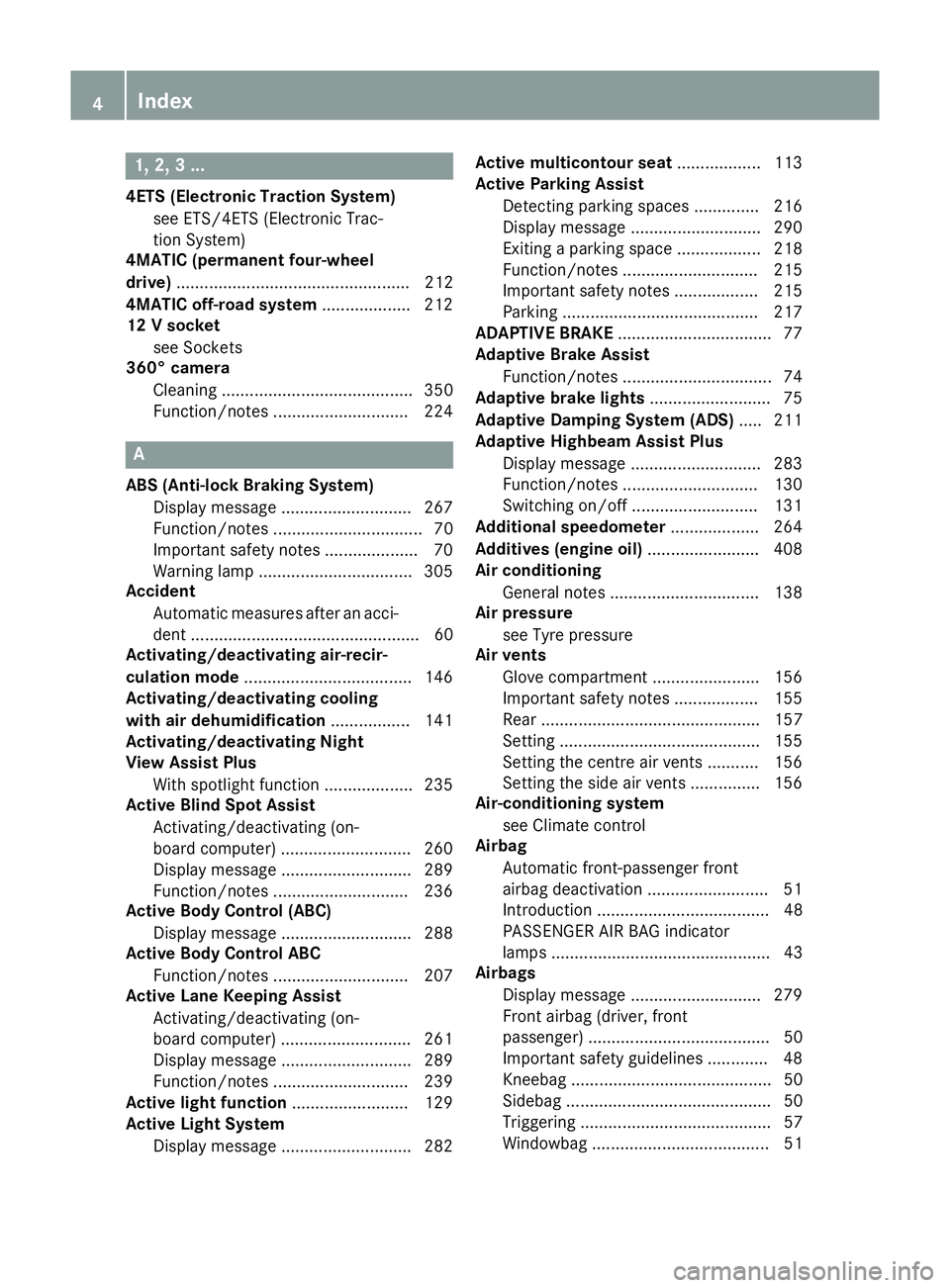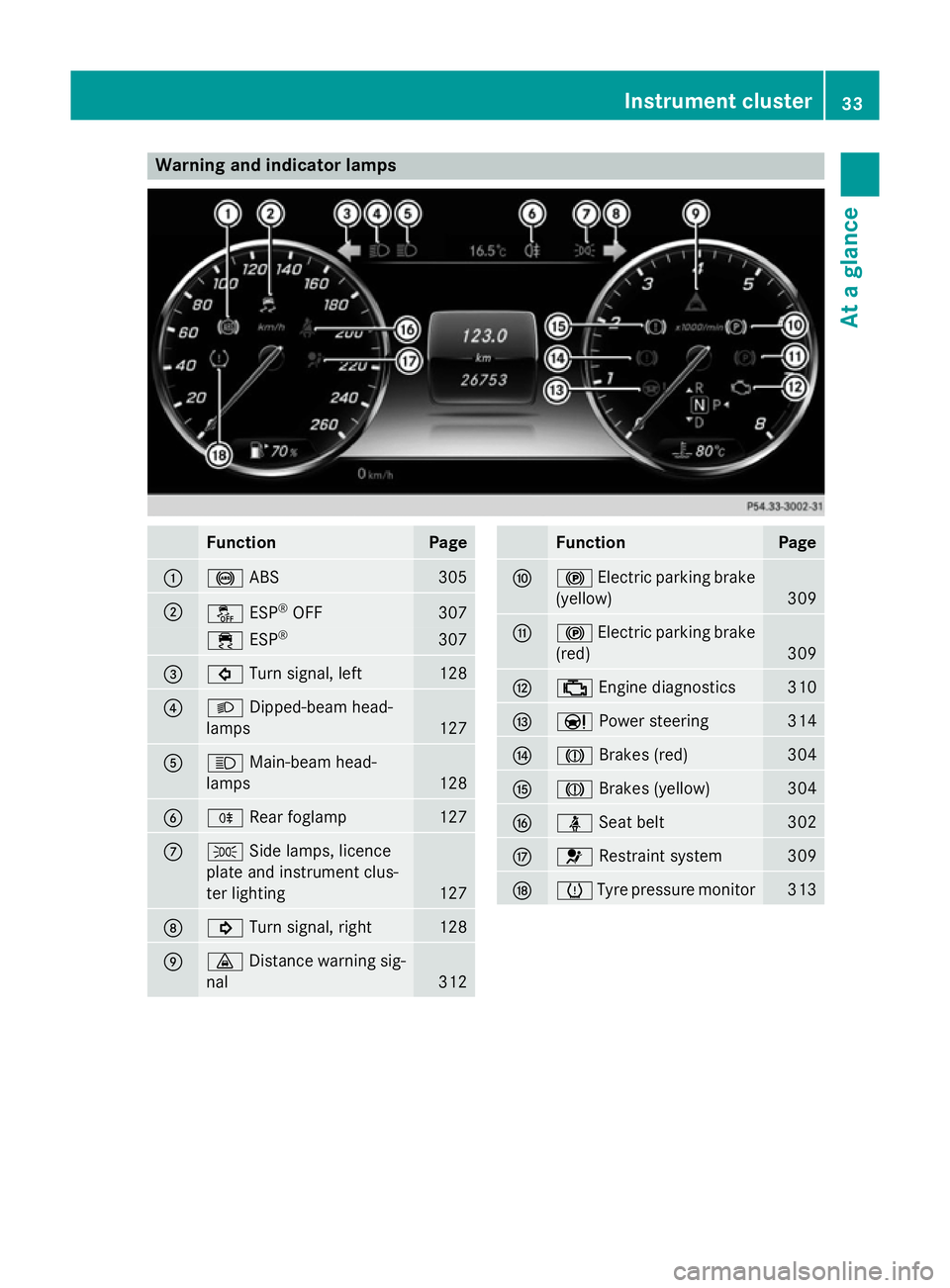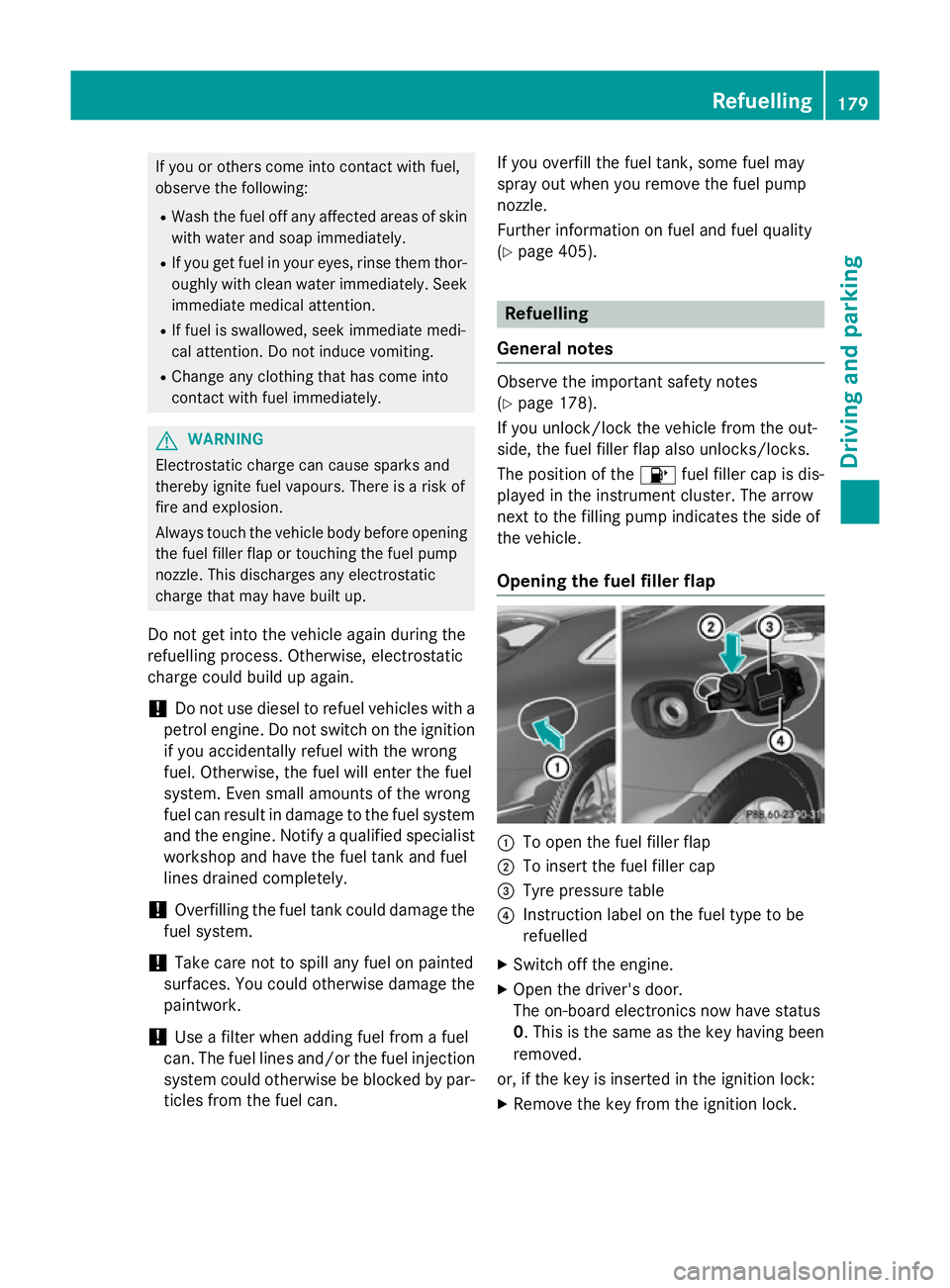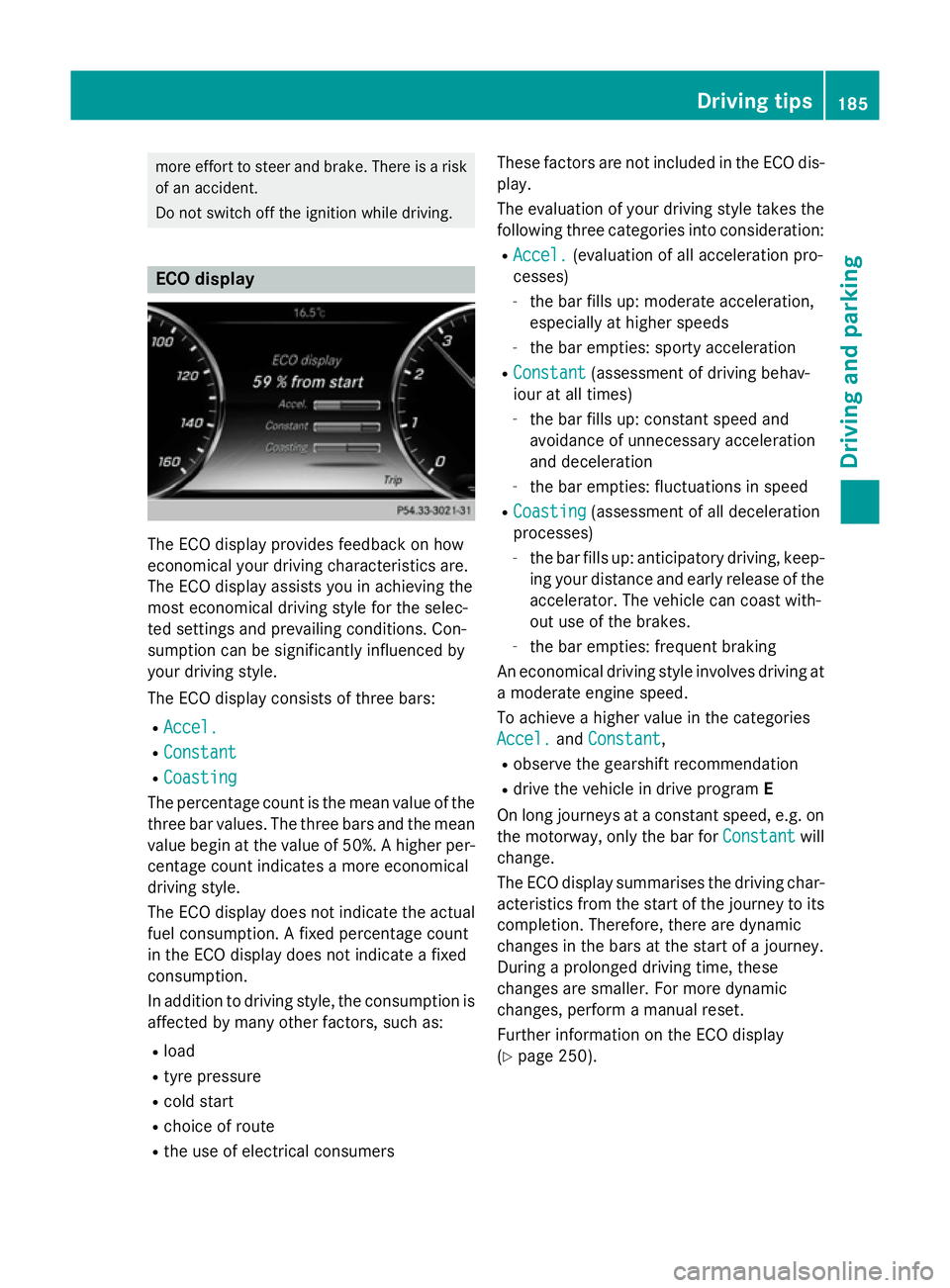2015 MERCEDES-BENZ S-CLASS COUPE tyre pressure
[x] Cancel search: tyre pressurePage 7 of 417

1, 2, 3 ...
4ETS (Electronic Traction System) see ETS/4ETS (Electronic Trac-
tion System)
4MATIC (permanent four-wheel
drive) .................................................. 212
4MATIC off-road system ...................212
12 V socket
see Sockets
360° camera
Cleaning ......................................... 350
Function/notes ............................ .224 A
ABS (Anti-lock Braking System) Display message ............................ 267
Function/notes ................................ 70
Important safety notes .................... 70
Warning lamp ................................. 305
Accident
Automatic measures after an acci-
dent ................................................. 60
Activating/deactivating air-recir-
culation mode ................................... .146
Activating/deactivating cooling
with air dehumidification ................. 141
Activating/deactivating Night
View Assist Plus
With spotlight function ................... 235
Active Blind Spot Assist
Activating/deactivating (on-
board computer) ............................ 260
Display message ............................ 289
Function/notes ............................ .236
Active Body Control (ABC)
Display message ............................ 288
Active Body Control ABC
Function/notes ............................ .207
Active Lane Keeping Assist
Activating/deactivating (on-
board computer) ............................ 261
Display message ............................ 289
Function/notes ............................ .239
Active light function ......................... 129
Active Light System
Display message ............................ 282 Active multicontour seat
.................. 113
Active Parking Assist
Detecting parking spaces .............. 216
Display message ............................ 290
Exiting a parking space .................. 218
Function/notes ............................ .215
Important safety notes .................. 215
Parking .......................................... 217
ADAPTIVE BRAKE ................................. 77
Adaptive Brake Assist
Function/notes ................................ 74
Adaptive brake lights .......................... 75
Adaptive Damping System (ADS) ..... 211
Adaptive Highbeam Assist Plus
Display message ............................ 283
Function/notes ............................ .130
Switching on/off ........................... 131
Additional speedometer ................... 264
Additives (engine oil) ........................ 408
Air conditioning
General notes ................................ 138
Air pressure
see Tyre pressure
Air vents
Glove compartment ....................... 156
Important safety notes .................. 155
Rear ............................................... 157
Setting .......................................... .155
Setting the centre air vents ........... 156
Setting the side air vents .............. .156
Air-conditioning system
see Climate control
Airbag
Automatic front-passenger front
airbag deactivatio n.......................... 51
Introduction ..................................... 48
PASSENGER AIR BAG indicator
lamps ............................................... 43
Airbags
Display message ............................ 279
Front airbag (driver, front
passenger) ....................................... 50
Important safety guidelines ............. 48
Kneebag ........................................... 50
Sidebag ............................................ 50
Triggering ......................................... 57
Windowba g...................................... 51 4
Index
Page 23 of 417

TIREFIT kit
.......................................... 359
Tyre pressure not reached ............. 361
Tyre pressure reache d................... 361
Top Tether ............................................ 62
Total distance recorder .................... 249
Tow-away protection
Activating ......................................... 81
Deactivating ..................................... 81
Function ........................................... 81
Tow-starting
Emergency engine starting ............ 372
Important safety notes .................. 369
Towing
Important safety notes .................. 369
Notes for 4MATIC vehicles ............ 372
Transporting the vehicle ................ 371
With the rear axle raised ................ 371
Towing away
Fitting the towing eye .................... 370
Removing the towing eye ............... 371
With both axles on the ground ....... 371
Towing eye ......................................... 357
Traffic Sign Assist
Activating ....................................... 231
Display message ............................ 291
Function/note s............................. 230
Important safety notes .................. 230
Instrument cluster display ............. 231
Switching on/of f........................... 259
Transmission
see Automatic transmission
Transporting the vehicle .................. 371
Trim pieces (cleaning instruc-
tions) .................................................. 352
Trip computer (on-board com-
puter) .................................................. 250
Trip meter
Calling up ....................................... 249
Resetting (on-board computer) ...... 251
Turn signals
Switching on/of f........................... 128
TV
Operating (on-board computer) ..... 255
Two-way radio
Frequencies ................................... 402
Installation ..................................... 402
Transmission output (maximum) .... 402 Windscreen (infrared reflective) ..... 336
Type identification plate
see Vehicle identification plate
Tyre pressure
Calling up (on-board computer) ..... 381
Display message ............................ 295
Not reached (TIREFIT) .................... 361
Reached (TIREFIT) .......................... 361
Recommended ............................... 380
Tyre pressure loss warning
General notes ................................ 384
Important safety notes .................. 384
Restarting ...................................... 385
Tyre pressure monitor
Checking the tyre pressure elec-
tronically ........................................ 382
Function/note s............................. 381
General notes ................................ 381
Important safety notes .................. 381
Radio type approval for the tyre
pressure monitor ........................... 384
Restarting ...................................... 383
Warning lamp ................................. 313
Warning message .......................... 383
Tyres
Changing a whee l.......................... 385
Checking ........................................ 377
Direction of rotation ...................... 386
Display message ............................ 295
General notes ................................ 391
Important safety notes .................. 376
Information on driving .................... 376
MOExtended tyre s......................... 378
Replacing ....................................... 386
Service life ..................................... 377
Snow chains .................................. 379
Storing ........................................... 386
Summer tyres in winter ................. 378
Tyre size (data ).............................. 391
Tyre tread ...................................... 377
Wheel and tyre combinations ........ 393
see Flat tyre U
Unlocking Emergency unlocking ....................... 93 20
Index
Page 24 of 417

From inside the vehicle (central
unlocking button) ............................. 91
Upshift indicator (on-board com-
puter, Mercedes-AMG vehicles) ....... 265V
Vanity mirror (in sun visor) .............. 323
Variable SPEEDTRONIC
see SPEEDTRONIC
Vehicle
Correct use ...................................... 26
Data acquisition ............................... 27
Display messag e............................ 297
Electronics ..................................... 402
Equipment ....................................... 24
Implied warranty .............................. 26
Individual settings .......................... 258
Leaving parked up ......................... 184
Locking (in an emergency) ............... 93
Locking (key) ................................... 85
Lowering ........................................ 390
Operating safety .............................. 24
Parking .......................................... 181
Pulling away ................................... 164
Raising ........................................... 387
Registration ..................................... 26
Securing from rolling away ............ 387
Towing away .................................. 369
Transporting .................................. 371
Unlocking (in an emergency) ........... 93
Unlocking (key) ................................ 85
Vehicle data ................................... 410
Vehicle dimensions ........................... 410
Vehicle emergency locking ................ 93
Vehicle identification number
see VIN
Vehicle identification plate .............. 404
Vehicle level
Active Body Control ABC ............... 207
AIRMATIC ...................................... 210
Display message ............................ 287
Vehicle tool kit .................................. 357
Video
Operating the DVD ......................... 255
VIN ...................................................... 404 W
Warning and indicator lamps ABS ................................................ 305
Brakes ........................................... 304
Distance warning signal ................. 312
ESP ®
.............................................. 307
ESP ®
OFF ....................................... 308
Fuel tank ........................................ 310
General notes ................................ 302
LIM (cruise control) ........................ 189
LIM (DISTRONIC PLUS) .................. 196
LIM (variable SPEEDTRONIC) ......... 192
Overview .......................................... 33
Parking brake ................................ 309
PASSENGER AIR BAG ...................... 43
Reserve fuel ................................... 310
Seat belt ........................................ 302
Steering ......................................... 314
Tyre pressure monitor ................... 313
Warning triangle ................................ 356
Washer fluid
Display message ............................ 300
Wheel and tyre combinations
Tyres .............................................. 393
Wheel bolt tightening torque ........... 390
Wheel chock ...................................... 387
Wheels
Changing a whee l.......................... 385
Changing/replacing ....................... 386
Checking ........................................ 377
Cleaning ......................................... 348
Fitting a new wheel ........................ 390
Fitting a wheel ............................... 386
General notes ................................ 391
Important safety notes .................. 376
Information on driving .................... 376
Removing a whee l.......................... 389
Snow chains .................................. 379
Storing ........................................... 386
Tightening torque ........................... 390
Wheel size/tyre size ...................... 391
Windowbag
Operation ......................................... 51
Windows
Cleaning ......................................... 348
see Side windows Index
21
Page 26 of 417

Protection of the environment
General notes
H
Environmental note
Daimler's declared policy is one of compre-
hensive environmental protection.
Our objectives are to use the natural resour-
ces which form the basis of our existence on
this planet sparingly and in a manner which
takes the requirements of both nature and
humanity into consideration.
You too can help to protect the environment
by operating your vehicle in an environmen-
tally-responsible manner.
Fuel consumption and the rate of engine,
transmission, brake and tyre wear depend on
the following factors:
R operating conditions of your vehicle
R your personal driving style
You can influence both factors. Therefore,
please bear the following in mind:
Operating conditions:
R avoid short trips, as these increase fuel
consumption.
R observe the correct tyre pressure.
R do not carry any unnecessary weight in the
vehicle.
R remove the roof rack once you no longer
need it.
R a regularly serviced vehicle will contribute
to environmental protection. You should
therefore adhere to the service intervals.
R all maintenance work should be carried out
at a qualified specialist workshop.
Personal driving style:
R do not depress the accelerator pedal when
starting the engine.
R do not warm up the engine when the vehicle
is stationary.
R drive carefully and maintain a safe distance
from the vehicle in front.
R avoid frequent, sudden acceleration and
braking. R
change gear in good time and use each gear
only up to Ôof its maximum engine speed.
R switch off the engine in stationary traffic.
R monitor the vehicle's fuel consumption. Returning an end-of-life vehicle
EU countries only:
Mercedes-Benz will take back your old vehicle to dispose of it in an environmentally-respon-sible manner in accordance with the Euro-
pean Union (EU) End of Life Vehicles Direc-
tive.
There is a network of return points and dis-
assembly plants available. You can return
your vehicle to these plants free of charge.
This makes a valuable contribution to the
recycling process and the conservation of
resources.
For further information on recycling old vehi- cles, recovery and the terms of the policy,
visit the Mercedes-Benz homepage. Genuine Mercedes-Benz parts
H
Environmental note
Daimler AG also supplies reconditioned
assemblies and parts which are of the same
quality as new parts. For these, the same war-
ranty applies as for new parts.
! Airbags and seat belt tensioners, as well
as control units and sensors for these
restraint systems, may be installed in the
following areas of your vehicle:
R doors
R door pillars
R door sills
R seats
R dashboard
R instrument cluster
R centre console Introduction
23 Z
Page 36 of 417

Warning and indicator lamps
Function Page
:
!
ABS 305
;
å
ESP®
OFF 307
÷
ESP® 307
=
#
Turn signal, left 128
?
L
Dipped-beam head-
lamps 127
A
K
Main-beam head-
lamps 128
B
R
Rear foglamp 127
C
T
Side lamps, licence
plate and instrument clus-
ter lighting 127
D
!
Turn signal, right 128
E
·
Distance warning sig-
nal 312 Function Page
F
!
Electric parking brake
(yellow) 309
G
!
Electric parking brake
(red) 309
H
;
Engine diagnostics 310
I
Ð
Power steering 314
J
J
Brakes (red) 304
K
J
Brakes (yellow) 304
L
ü
Seat belt 302
M
6
Restraint system 309
N
h
Tyre pressure monitor 313Instrument cluster
33At a glance
Page 73 of 417

override the laws of physics. Driving safety
systems are merely aids designed to assist
driving. You are responsible for maintaining
the distance to the vehicle in front, for vehicle
speed, for braking in good time, and for stay- ing in lane. Always adapt your driving style to
suit the prevailing road and weather condi-
tions and maintain a safe distance from the
vehicle in front. Drive carefully.
The driving safety systems described only
work as effectively as possible when there is
adequate contact between the tyres and the
road surface. Please pay special attention to
the notes on tyres, recommended minimum
tyre tread depths etc. (Y page 376).
In wintry driving conditions, always use winter
tyres (M+S tyres) and, if necessary, snow
chains. Only in this way will the driving safety
systems described in this section work as
effectively as possible. ABS (Anti-lock Braking System)
General notes ABS regulates brake pressure in such a way
that the wheels do not lock when you brake.
This allows you to continue steering the vehi- cle when braking.
The ! ABS warning lamp in the instrument
cluster lights up when the ignition is switched on. It goes out when the engine is running.
ABS works from a speed of about 8 km/h,
regardless of road-surface conditions. ABS
works on slippery surfaces, even when you
only brake gently.
Important safety notes i
Observe the "Important safety notes" sec-
tion (Y page 69). G
WARNING
If ABS is faulty, the wheels could lock when
braking. The steerability and braking charac-
teristics may be severely impaired. Addition-
ally, further driving safety systems are deac- tivated. There is an increased danger of skid-
ding and accidents.
Drive on carefully. Have ABS checked imme-
diately at a qualified specialist workshop.
If ABS is malfunctioning, other systems,
including driving safety systems, will also
become inoperative. Observe the information on the ABS warning lamp (Y page 305) and
display messages which may be shown in the
instrument cluster (Y page 267).
Brakes X
If ABS intervenes: continue to depress the
brake pedal with force until the braking sit- uation is over.
X To make a full brake application:
depress the brake pedal with full force.
If ABS intervenes when braking, you will feel a
pulsing in the brake pedal.
The pulsating brake pedal can be an indica-
tion of hazardous road conditions; this serves as a reminder to take extra care while driving. BAS (Brake Assist)
General notes BAS operates in emergency braking situa-
tions. If you depress the brake pedal quickly,
BAS automatically boosts the braking force,
thus shortening the stopping distance.
Important safety notes i
Observe the "Important safety notes" sec-
tion (Y page 69). G
WARNING
If BAS is malfunctioning, the braking distance
in an emergency braking situation is
increased. There is a risk of accident.
In an emergency braking situation, depress
the brake pedal with full force. ABS prevents
the wheels from locking. 70
Driving safety systemsSafety
Page 182 of 417

If you or others come into contact with fuel,
observe the following:
R Wash the fuel off any affected areas of skin
with water and soap immediately.
R If you get fuel in your eyes, rinse them thor-
oughly with clean water immediately. Seek
immediate medical attention.
R If fuel is swallowed, seek immediate medi-
cal attention. Do not induce vomiting.
R Change any clothing that has come into
contact with fuel immediately. G
WARNING
Electrostatic charge can cause sparks and
thereby ignite fuel vapours. There is a risk of
fire and explosion.
Always touch the vehicle body before opening the fuel filler flap or touching the fuel pump
nozzle. This discharges any electrostatic
charge that may have built up.
Do not get into the vehicle again during the
refuelling process. Otherwise, electrostatic
charge could build up again.
! Do not use diesel to refuel vehicles with a
petrol engine. Do not switch on the ignition if you accidentally refuel with the wrong
fuel. Otherwise, the fuel will enter the fuel
system. Even small amounts of the wrong
fuel can result in damage to the fuel system
and the engine. Notify a qualified specialist
workshop and have the fuel tank and fuel
lines drained completely.
! Overfilling the fuel tank could damage the
fuel system.
! Take care not to spill any fuel on painted
surfaces. You could otherwise damage the
paintwork.
! Use a filter when adding fuel from a fuel
can. The fuel lines and/or the fuel injection
system could otherwise be blocked by par- ticles from the fuel can. If you overfill the fuel tank, some fuel may
spray out when you remove the fuel pump
nozzle.
Further information on fuel and fuel quality
(Y
page 405). Refuelling
General notes Observe the important safety notes
(Y
page 178).
If you unlock/lock the vehicle from the out-
side, the fuel filler flap also unlocks/locks.
The position of the 8fuel filler cap is dis-
played in the instrument cluster. The arrow
next to the filling pump indicates the side of
the vehicle.
Opening the fuel filler flap :
To open the fuel filler flap
; To insert the fuel filler cap
= Tyre pressure table
? Instruction label on the fuel type to be
refuelled
X Switch off the engine.
X Open the driver's door.
The on-board electronics now have status
0. This is the same as the key having been
removed.
or, if the key is inserted in the ignition lock: X Remove the key from the ignition lock. Refuelling
179Driving and parking Z
Page 188 of 417

more effort to steer and brake. There is a risk
of an accident.
Do not switch off the ignition while driving. ECO display
The ECO display provides feedback on how
economical your driving characteristics are.
The ECO display assists you in achieving the
most economical driving style for the selec-
ted settings and prevailing conditions. Con-
sumption can be significantly influenced by
your driving style.
The ECO display consists of three bars:
R Accel.
Accel.
R Constant Constant
R Coasting
Coasting
The percentage count is the mean value of the three bar values. The three bars and the mean
value begin at the value of 50%. A higher per-
centage count indicates a more economical
driving style.
The ECO display does not indicate the actual fuel consumption. A fixed percentage count
in the ECO display does not indicate a fixed
consumption.
In addition to driving style, the consumption is
affected by many other factors, such as:
R load
R tyre pressure
R cold start
R choice of route
R the use of electrical consumers These factors are not included in the ECO dis-
play.
The evaluation of your driving style takes the following three categories into consideration:
R Accel.
Accel. (evaluation of all acceleration pro-
cesses)
- the bar fills up: moderate acceleration,
especially at higher speeds
- the bar empties: sporty acceleration
R Constant Constant (assessment of driving behav-
iour at all times)
- the bar fills up: constant speed and
avoidance of unnecessary acceleration
and deceleration
- the bar empties: fluctuations in speed
R Coasting Coasting (assessment of all deceleration
processes)
- the bar fills up: anticipatory driving, keep-
ing your distance and early release of the
accelerator. The vehicle can coast with-
out use of the brakes.
- the bar empties: frequent braking
An economical driving style involves driving at a moderate engine speed.
To achieve a higher value in the categories
Accel. Accel. andConstant
Constant,
R observe the gearshift recommendation
R drive the vehicle in drive program E
On long journeys at a constant speed, e.g. on the motorway, only the bar for Constant
Constantwill
change.
The ECO display summarises the driving char-
acteristics from the start of the journey to its completion. Therefore, there are dynamic
changes in the bars at the start of a journey.
During a prolonged driving time, these
changes are smaller. For more dynamic
changes, perform a manual reset.
Further information on the ECO display
(Y page 250). Driving tips
185Driving and parking Z